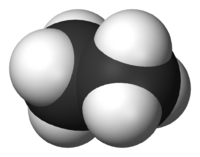Ethane: Difference between revisions
J.williams (talk | contribs) m (1 revision imported) |
m (1 revision imported) |
||
| (3 intermediate revisions by 3 users not shown) | |||
| Line 1: | Line 1: | ||
[[Category:Done | [[Category:Done 2020-01-31]] | ||
[[File:Ethane-3D-vdW.png|thumb| | [[Category: Translated to French]] | ||
[[File:Ethane-3D-vdW.png|thumb|200px|Figure 1. Space filling model of ethane, the white is [[hydrogen]] and the black is [[carbon]].<ref>"Ethane-3D-vdW". Licensed under Public Domain via Wikimedia Commons - http://commons.wikimedia.org/wiki/File:Ethane-3D-vdW.png#mediaviewer/File:Ethane-3D-vdW.png</ref>]] | |||
<onlyinclude>'''Ethane''' is | <onlyinclude>'''Ethane''' is an [[alkane]] with the chemical formula C<sub>2</sub>H<sub>6</sub>. As a [[hydrocarbon]], it can undergo [[hydrocarbon combustion]] which gives off [[heat]]. Ethane is one of the [[hydrocarbon]] components of [[natural gas]], which is a type of [[fossil fuel]].</onlyinclude><ref>“NATURAL GAS FAQs,” Pacific Northern Gas RSS. [Online]. Available: http://www.png.ca/natural-gas-faqs/. [Accessed: 24-May-2017]</ref> In its purest form, ethane is a colourless, odourless substance. This [[gas]] is often put under enough pressure to turn into a [[liquid]]. | ||
==Properties== | ==Properties== | ||
Below is a table of some | Below is a table of some basic properties of ethane. | ||
{| class="wikitable" | {| class="wikitable" | ||
| Line 24: | Line 20: | ||
| Boiling Point || -89<sup>o</sup>C<ref name =elmhurst/> | | Boiling Point || -89<sup>o</sup>C<ref name =elmhurst/> | ||
|} | |} | ||
==Combustion Reaction== | |||
Ethane undergoes [[hydrocarbon combustion]], combining with [[oxygen]] to form [[carbon dioxide]]. The balanced chemical equation for the complete combustion of ethane is:<ref> Dr. Colin France. (2014). ''Products from Oil - The Combustion of Hydrocarbons '' [Online]. Available: http://www.gcsescience.com/o30.htm [February 16, 2015].</ref> | |||
<center> 2 (C<sub>2</sub>H<sub>6</sub>) + 7 (O<sub>2</sub>) → 4(CO<sub>2</sub>) + 6(H<sub>2</sub>O) + Heat Energy ([[Enthalpy]]) </center> | |||
The [[hydrocarbon combustion]] reaction releases heat [[energy]] and is an example of an [[exothermic reaction]]. The reaction also has a negative [[enthalpy]] change (ΔH) value. | |||
==For Further Reading== | |||
*[[Chemical energy]] | |||
*[[Chemical bond]] | |||
*[[Combustion]] | |||
*[[Primary energy]] | |||
*[[Energy conversion technology]] | |||
*Or explore a [[Special:Random|random page]] | |||
Latest revision as of 00:02, 27 September 2021
Ethane is an alkane with the chemical formula C2H6. As a hydrocarbon, it can undergo hydrocarbon combustion which gives off heat. Ethane is one of the hydrocarbon components of natural gas, which is a type of fossil fuel.[2] In its purest form, ethane is a colourless, odourless substance. This gas is often put under enough pressure to turn into a liquid.
Properties
Below is a table of some basic properties of ethane.
| Chemical formula | C2H6 |
| Molar mass | 30.1 grams/mole |
| Energy density | 53.2 MJ/kg [3] |
| Melting Point | -183oC[4] |
| Boiling Point | -89oC[4] |
Combustion Reaction
Ethane undergoes hydrocarbon combustion, combining with oxygen to form carbon dioxide. The balanced chemical equation for the complete combustion of ethane is:[5]
The hydrocarbon combustion reaction releases heat energy and is an example of an exothermic reaction. The reaction also has a negative enthalpy change (ΔH) value.
For Further Reading
- Chemical energy
- Chemical bond
- Combustion
- Primary energy
- Energy conversion technology
- Or explore a random page
References
- ↑ "Ethane-3D-vdW". Licensed under Public Domain via Wikimedia Commons - http://commons.wikimedia.org/wiki/File:Ethane-3D-vdW.png#mediaviewer/File:Ethane-3D-vdW.png
- ↑ “NATURAL GAS FAQs,” Pacific Northern Gas RSS. [Online]. Available: http://www.png.ca/natural-gas-faqs/. [Accessed: 24-May-2017]
- ↑ Glenn Elert. (2015). The Physics Hypertextbook - Chemical Potential Energy [Online]. Available: http://physics.info/energy-chemical/ [February 16, 2015].
- ↑ 4.0 4.1 Charles E. Ophardt. (2003). Virtual Chembook - Hydrocarbon Boiling Points [Online]. Available: http://www.elmhurst.edu/~chm/vchembook/501hcboilingpts.html [February 16,2015].
- ↑ Dr. Colin France. (2014). Products from Oil - The Combustion of Hydrocarbons [Online]. Available: http://www.gcsescience.com/o30.htm [February 16, 2015].


